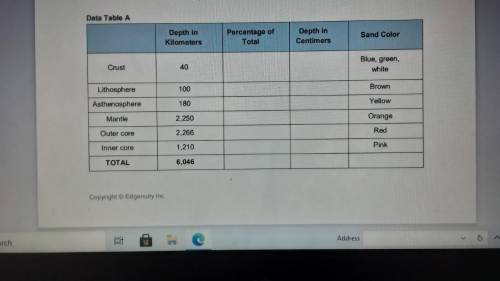HELP
Project: Earth’s Layers
Divide the depth of the layer by the total depth. For exam...

Social Studies, 13.12.2020 23:00, kaishasenat1986
HELP
Project: Earth’s Layers
Divide the depth of the layer by the total depth. For example, to calculate the percentage
of the total depth that the crust represents, divide 40 by 6,046.
ii. Write your answer in the Percent column.
iii. Repeat for the rest of the layers.
b) Use the calculator to determine the depth in centimeters for each layer. This is the depth of sand
you will put in your jar.
i. Multiply the depth of the jar, 16.5 cm, by the percent you calculated for the crust.
ii. Write your answer in the Centimeters column.
iii. Repeat for the rest of the layers.
Step 3: Fill the jar with sand to create your core sample.
a) Find the depth in centimeters for the inner core on your table.
b) Use the ruler to measure how deep the sand should be in the jar.
c) Locate the correct color of sand for each layer in the data table.
d) Using the funnel, pour in the correct color of sand to the correct depth.
e) Repeat for the rest of the layers.
f) For the final layer, the crust, be creative! Make some oceans, green land, mountains, and clouds.
Step 4: Label the layers, using the permanent marker and labels.
Step 5: Create a typewritten paper describing your model of Earth’s layers.
a) Type several paragraphs describing your “core sample” of Earth’s layers in detail.
i. Explain what a core sample is. Then, tell whether it is currently possible to take a core
sample like the model you’ve created.
ii. Compare and contrast the layers in your model, including the significance of the
colors.
iii. Discuss what it means to create a scale model.
iv. Include a table with the values you determined for each layer.
v. Discuss the relationships of each layer to the others, including depth.
b) Answer the following question in a separate paragraph.
i. How does your “core sample” model of Earth’s layers differ from the actual layers of
the Earth?
c) Make sure your paragraphs include correct sentence structure, punctuation, grammar, and
spelling.
d) Ask your teacher where you should save your work. Your teacher may also have specific
guidelines about the file name you should use.
Step 6: Evaluate your project using this checklist.
If you can check each box below, you are ready to submit your project.
Core sample model
Is your name on your core sample?
Did your model show the use the correct colors of sand?


Answers: 3
Other questions on the subject: Social Studies

Social Studies, 22.06.2019 03:30, stevenssimeon30
Lava and other matierls luanced from a volcano and into the air are referenced as
Answers: 1

Social Studies, 22.06.2019 10:00, etiryung
According to ohrp, a problem is an “unanticipated problem” when it meets which of the following criteria: unexpected, related or possibly related to the research, suggests that the research does not put the subjects or others at greater riskunexpected, related or possible related to the research, suggests the research puts subjects or others at greater riskunexpected, unrelated to the research but still occurring with a subject, suggests the research puts others at greater riskexpected, related or possible related to the research, suggests the research puts others at greater risk
Answers: 2


Social Studies, 23.06.2019 03:30, sindy35111
Energy is the total kinetic energy of particles of matter.(chose wisely & pick one) a. mechanical b. thermal c. electrical d. chemical
Answers: 1
Do you know the correct answer?
Questions in other subjects:

Biology, 30.01.2020 00:02

Biology, 30.01.2020 00:02



Biology, 30.01.2020 00:03


Biology, 30.01.2020 00:03


Mathematics, 30.01.2020 00:03






